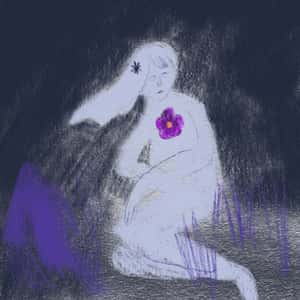She Dwelt among the Untrodden Ways was written in 1798. This poem is Wordsworth’s best known work from a series of five texts that form his “Lucy” series. In this series, Wordsworth examines an idealized and unrequited love for Lucy, a girl who has died young
The poem examines loneliness and loss, but also unrecognized beauty and dignity. She Dwelt among the Untrodden Ways has three quatrains with simple language (mainly words of one syllable), and it has an ABAB rhyme scheme. Furthermore, Wordsworth’s poem can be read as an elegiac poem, with graceful descriptions and a mourning tone. Thus, She Dwelt among the Untrodden Ways’s main theme is death, a death that is described and grieved for throughout the entire poem.
She Dwelt among the Untrodden Ways is a prototypical representative of a Romantic poem. The poem celebrates a girl by associating her to nature with straightforward language and emphasizing on emotional expression. Moreover, it is a short lyric form that concerns rural life.
She Dwelt among the Untrodden Ways Analysis
First Stanza
She dwelt among the untrodden ways
Beside the springs of Dove,
A Maid whom there were none to praise
And very few to love:
The first stanza describes the area in which Lucy (“She”) lived. This rural scenery is described as a locus amoenus, an idealized beautiful place. From the first line, the lyrical voice refers to a “She”, his/her loved one that will later acquire a name (“Lucy”). Notice how it is described that she “dwelt”, meaning that she lived there in the past. Although this rural scenery is described as idyllic and magnificent place (“among the untrodden ways/Beside the springs of Dove”), Lucy was alone and there was no one to praise her and to love her (A Maid whom there were none to praise/ And very few to love”). The first line, which serves also as the title of the poem, suggests that Lucy lived both physically and spiritually unrevealed and distant.
Second Stanza
A violet by a mossy stone
Half hidden from the eye!
—Fair as a star, when only one
Is shining in the sky.
The second stanza focuses on nature. As a representative Romanic device, the lyrical voice compares the beauty of nature to the grace of Lucy. She is likened to “A violet by a mossy stone/ Half hidden from the eye” and to a fair star “when only one/Is shining in the sky”. These comparisons serve to exemplify Lucy as an embodiment of all beauty. Notice how her description is made by an economic use of words, as they depict Lucy’s simplicity by using short, straightforward, everyday words. This word usage creates a meaningful and powerful poetry that emphasizes on passionate feelings of love and grief.
Third Stanza
She lived unknown, and few could know
When Lucy ceased to be;
But she is in her grave, and, oh,
The difference to me!
The final stanza serves as an antithesis. The lyrical voice accentuates her isolation: “She lived unknown, and few could know/ When Lucy ceased to be;”. The poem follows a cyclical pattern. Notice how this stanza repeats the characterization of Lucy as distant and unknown (like in the first stanza). Moreover, this cycle is also related to the movement between growth and death (In the first stanza she is presented as alive, whereas in the last stanza the lyrical voice talks about her death). This cyclical form conveys great dramatic intensity. Lucy’s death is expressed with great sadness: “But she is in her grave, and, oh”. Love is asserted by the lyrical voice’s exclamation of difference (“The difference to me!”). The lyrical voice, dissimilarly from others, feels that he/she is unlike he/she was before because he/she could love her passionately, and that changed him/her. This “difference” functions powerfully trough understatement, and establishes a dramatic ending for the poem. Notice how, throughout the poem, the lyrical voice focuses on his experience and how Lucy affected him/her rather than his/her beloved one herself (this is another recurrent characteristic of the Romantic Movement).
About William Wordsworth
WillدW.W was born in 1770 and died in 1850. He was an English poet and one of the best known figures of the Romantic period. Alongside Samuel Taylor Coleridge, William Wordsworth wrote Lyrical Ballads, and the publication of this collection launched the Romantic Age in English literature in 1798. However, Wordsworth’s most important work is said to a semi-autobiographical poem that he wrote in his youth. This poem was revised several times, and William Wordsworth worked on it during his whole life. The Prelude was published posthumously.
As a central figure of the Romantic Movement, William Wordsworth focused his poetry on the personification of nature and its relationship with men. Moreover, his poems describe intense emotions; these are the main source of his aesthetic experience. Also, past and nature are meant to be glorified by the use of spontaneous language.






 رد مع اقتباس
رد مع اقتباس